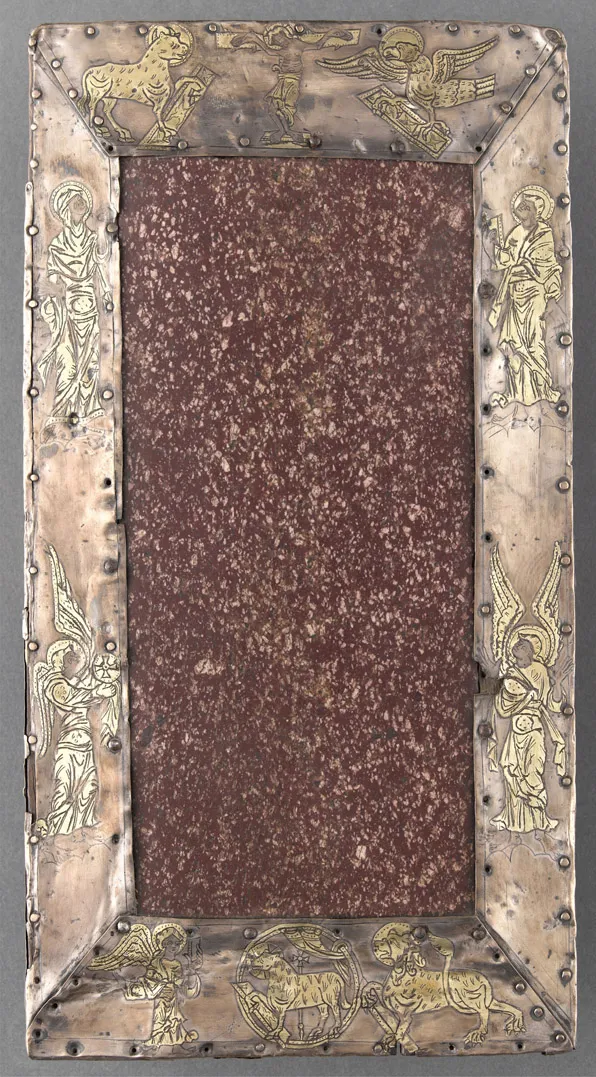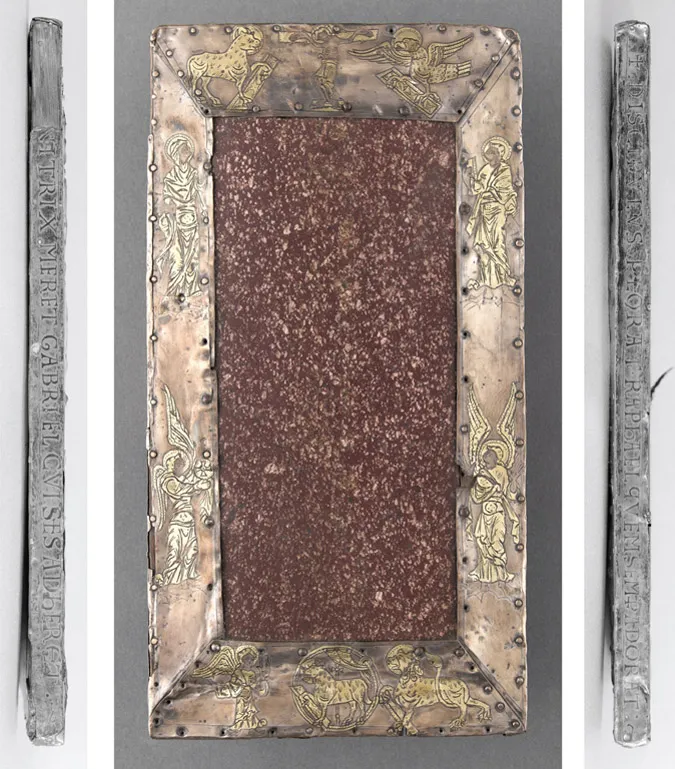+DISCIPVLVS PLORAT : RAPHAEL QVEM : SEMP¯ : ADORAT : + […] NITRIX : MERET : GABRIEL : CVI SC¯ S ADHERET : [+ I]NG[E..]T : HIC LV [....]RORE[.]−
The text contains several dots amongst the letters, some of which were probably word division symbols and some of which were perhaps accidental: it is not always certain, however, which is which. The horizontal mark above the G of GABRIEL was presumably accidental or in error, while the horizontal marks in
Since it is common for Anglo-Saxon inscriptions to commence with a cross, the text probably begins with the right-hand edge, the only edge to start with a cross. The first sentence of the text is, therefore, +discipulus plorat raphael quem semp adorat, probably ‘+ the disciple mourns him whom Raphael always worships’. In this interpretation semp is taken to be an abbreviation for semper and the word order is presumably inverted to fit the metrical structure of the line. The first two words of this sentence are located adjacent to the figure taken as St John and must refer to his grief at the Crucifixion. The second part of the sentence is placed alongside the engraved figure of an angel, who is thus presumably to be identified as Raphael. The odd-shaped cross following adorat may be decorative or perhaps a space filler, to avoid starting a new part of the text, and a new metrical line, close to the end of one edge of the altar. [33]
The second sentence begins on the upper part of the left-hand side where a small portion of silver is broken off. It reads,–nitrix meret gabriel cui scs adheret, probably ‘the Mother mourns, to whom the holy Gabriel cleaves’. In this interpretation–nitrix meret is taken to be a form of (ge)netrix maeret and scs to be sanctus. The inverted word order is presumably again to fit the metrical structure of the line. The first two words are set alongside the engraved figure of the Virgin Mary and refer to her mourning during the Crucifixion. The second part of the sentence is located adjacent to the engraved figure of the second angel, thus presumably identifying him as Gabriel. The final cross is rather deteriorated but may have been of the same unusual shape as the final cross on the right-hand side; again, it may have been inserted as decoration or as a space filler. The text on the bottom edge is now completely illegible, but some letters can be made out on the top edge. It is not now clear which of these two parts of the text would have followed the second sentence. The text on the top edge begins, (i)ng(e…)t hic lu–. The first word could be (i)ng(emi)t ‘he/she mourns’, though it is not certain to whom this would refer. Hic lu - is set alongside the engraved ox, the symbol of St Luke, and might refer to the saint or his symbol. H. Mitchell read further text here, pro rege and et ora.7 A reading (p)ro re(g) - would indeed fit the remaining traces, although several other readings are possible; there is, however, no sign now of et ora.
If the interpretation of the text put forward here is substantially correct, the following question arises: why did the engraver set that portion of the text on the left-hand edge with its letters facing the back of the altar, while setting the top and right-hand edge with their letters facing the front of the altar? A possible explanation is that the engraver, or perhaps his literate overseer, was aware that the words were describing the pictures. Working in a logical manner, he engraved the figures before starting to engrave the explanatory text. Whether the mounts were engraved before or after having been nailed into position on the altar is irrelevant to the present argument. When he engraved the first sentence no problem arose, since the words corresponded to the adjacent figures. When he came to engrave the left-hand edge, however, he noticed that the portion of the text referring to the Virgin would be beside Gabriel and that referring to Gabriel would be beside the Virgin. He therefore inverted the altar and engraved the second sentence so that the two portions were beside the figures they referred to, with the result that the letters faced the back of the altar.
It seems likely that such a long text would have been copied by the engraver from a written exemplar. Such an exemplar, however, could not have had the location of the figures and the corresponding parts of the text worked out in detail; had it had, the problem would surely have been rectified at that stage. It seems more likely that the somewhat confused situation presented by the altar is the result of problems which were recognised only during the engraving process.
Since the inscription is in Latin, no linguistic dating of the text is possible. The epigraphic dating evidence of the text supports the probable artistic dating of the altar to the eleventh century; it does not, however, suggest any more exact a date. The inscription from the left- and right-hand edges feature a bisyllabic leonine rhyme in each line (plorat-orat, meret-adheret), a metrical structure developed during the eleventh century,8 though [34] no example from an English author before the second quarter of the twelfth century has yet been found.9
The iconography
Jennifer O’Reilly
Lacking external clues to provenance and date, the Cluny altar was assigned to ...


